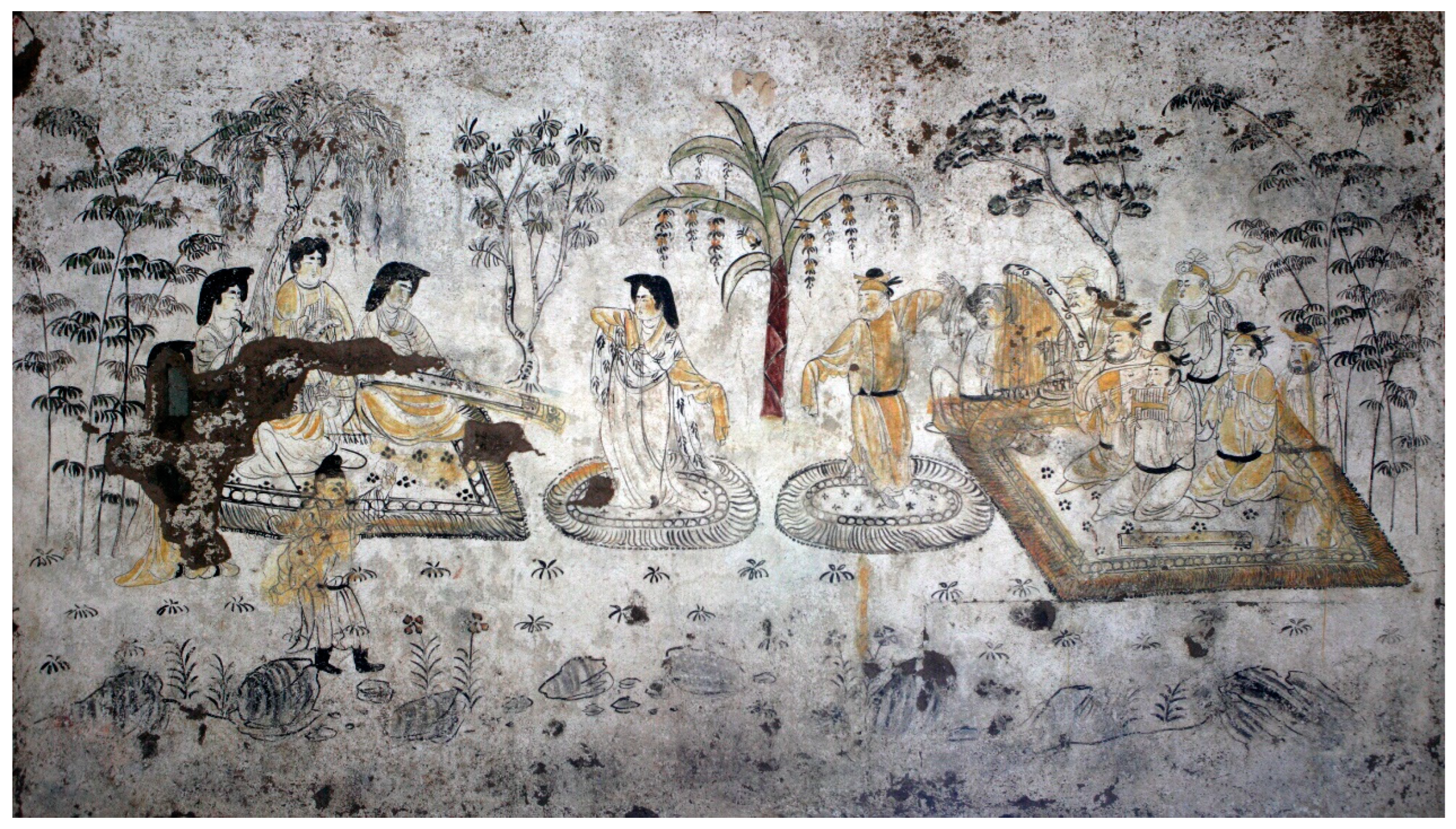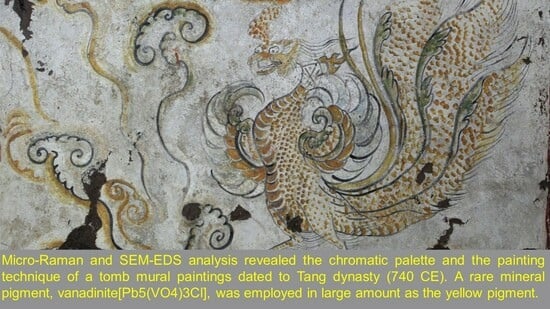Identification of the Pigments on the Mural Paintings from an Ancient Chinese Tomb of Tang Dynasty Using Micro-Raman and Scanning Electron Microscopy/Energy Dispersive X-ray Spectroscopy Analysis
Abstract
:1. Introduction
2. Archaeological Context
3. Materials and Methods
4. Results and Discussion
4.1. Yellow Pigment
4.2. Red Pigment
4.3. Green Pigment
4.4. Black Pigment
5. Concluding Remarks
Author Contributions
Funding
Data Availability Statement
Conflicts of Interest
References
- Chen, X.; Ma, Q.; Song, D.; Hu, Z.; Li, Z. An analysis of the black and white pigments of colored pottery at Majiayao by X-ray diffraction. J. Lanzhou Univ. (Nat. Sci.) 2004, 36, 54–58. (In Chinese) [Google Scholar]
- Shao, A.; Fu, Q.; Sun, Z.; Shao, J. The study of material and procedure of unearthed mural painting at Shimao site in Shenmu County, Shaanxi Province. Archaeology 2015, 6, 109–120. (In Chinese) [Google Scholar]
- Domingo, I.; Chieli, A. Characterizing the pigments and paints of prehistoric artists. Archaeol. Anthrop. Sci. 2021, 13, 196. [Google Scholar] [CrossRef]
- Ospitali, F.; Smith, D.C.; Lorblanchet, M. Preliminary investigations by Raman microscopy of prehistoric pigments in the wall-painted cave at Roucadour, Quercy, France. J. Raman Spectrosc. 2006, 37, 1063–1071. [Google Scholar] [CrossRef]
- Edwards, H.G.M.; Drummond, L.; Russ, J. Fourier transform Raman spectroscopic study of prehistoric rock paintings from the Big Bend region, Texas. J. Raman Spectrosc. 1999, 30, 421–428. [Google Scholar] [CrossRef]
- Hernanz, A.; Gavira-Vallejo, J.; Ruiz-Lopez, J.; Edwards, H.G.M. A comprehensive micro-Raman spectroscopic study of prehistoric rock paintings from the Sierra de las Cuerdas, Cuenca, Spain. J. Raman Spectrosc. 2008, 39, 972–984. [Google Scholar] [CrossRef]
- Lofrumento, C.; Ricci, M.; Bachechi, L.; Feo, D.; Castelluccie, E. The first spectroscopic analysis of Ethiopian prehistoric rock painting. J. Raman Spectrosc. 2012, 43, 809–816. [Google Scholar] [CrossRef]
- Zuo, J.; Wang, C.; Xu, C.; Qiu, P.; Xu, G.; Zhao, H. Raman microscopy study of the pigments on the ancient wall painting from the large grave in Wanzhang (Hebei, China). Spectrosc. Lett. 1999, 32, 841–850. [Google Scholar]
- Wang, X.; Wang, C.; Yang, J.; Chen, L.; Feng, J.; Shi, M. Study of wall-painting pigments from Feng Hui Tomb by Raman spectroscopy and high-resolution electron microscopy. J. Raman Spectrosc. 2004, 35, 274–278. [Google Scholar] [CrossRef]
- Zhang, Z.; Ma, Q.; Berke, H. Man-made blue and purple barium copper silicate pigments and the pabstite (BaSnSi3O9) mystery of ancient Chinese wall paintings from Luoyang. Herit. Sci. 2019, 7, 97–105. [Google Scholar] [CrossRef]
- Ma, W.; Wu, F.; Tian, T.; He, D.; Zhang, Q.; Gu, J.-D.; Duan, Y.; Ma, D.; Wang, W.; Feng, H. Fungal diversity and its contribution to the biodeterioration of mural paintings in two 1700-year-old tombs of China. Int. Biodeter. Biodegr. 2020, 152, 104972. [Google Scholar] [CrossRef]
- Zhang, Y.; Wang, J.; Zhang, T. Analysis on mural structures and components of the tombs in Liao Dynasty (A.D. 907–A.D. 1125). Spectrosc. Lett. 2015, 48, 732–740. [Google Scholar] [CrossRef]
- Guo, R.; Feng, J.; Liu, R.L.; Xia, Y.; Fu, Q.L.; Xi, N.; Wang, Z. Rare colour in medieval China: Case study of yellow pigments on tomb mural paintings at Xi’an, the capital of the Chinese Tang Dynasty. Archaeometry 2022, 64, 759–778. [Google Scholar] [CrossRef]
- Liu, Z.; Yang, R.; Wang, W.; Xu, W.; Zhang, M. Multi-analytical approach to the mural painting from an ancient tomb of Ming Dynasty in Jiyuan, China: Characterization of materials and techniques. Spectrochim. Acta Part A 2022, 279, 121419. [Google Scholar] [CrossRef] [PubMed]
- Luoyang Museum of Ancient Artwork. Ancient Tomb Mural Paintings in Luoyang; Zhongzhou Ancient Books Publishing House: Zhengzhou, China, 2010. [Google Scholar]
- Shaanxi History Museum. Research Report on the Conservation and Restoration of the Wall Paintings from the Tang Tombs; Sanqin Publishing House: Xi’an, China, 2011; ISBN 978-7-80736-955-4. [Google Scholar]
- Chalmers, M.; Edwards, H. (Eds.) Raman Spectroscopy in Archaeology and Art History; Royal Society of Chemistry: Cambridge, UK, 2005. [Google Scholar]
- Vandenabeele, P.; Edwards, H.G.M. (Eds.) Raman Spectroscopy in Archaeology and Art History: Volume 2; Royal Society of Chemistry: Cambridge, UK, 2018. [Google Scholar]
- Siddall, R. Mineral Pigments in Archaeology: Their Analysis and the Range of Available Materials. Minerals 2018, 8, 201–235. [Google Scholar] [CrossRef]
- Burgio, L.; Clark, R.J.H. Library of FT-Raman spectra of pigments, minerals, pigment media and varnishes, and supplement to existing library of Raman spectra of pigments with visible excitation. Spectrochim. Acta Part A 2001, 57, 1491–1521. [Google Scholar] [CrossRef]
- Bell, I.M.; Clark, R.J.H.; Gibbs, P.J. Raman spectroscopic library of natural and synthetic pigments (pre-~1850 AD). Spectrochim. Acta Part A 1997, 53, 2159–2179. [Google Scholar] [CrossRef]
- Bouchard, M.; Smith, D.C. Catalogue of 45 reference Raman spectra of minerals concerning research in art history or archaeology, especially on corroded metals and coloured glass. Spectrochim. Acta Part A 2003, 59, 2247–2266. [Google Scholar] [CrossRef]
- Database of Raman Spectra, X-ray Diffraction and Chemistry Data for Minerals. Available online: https://rruff.info/ (accessed on 13 April 2019).
- Loeffler, B.M.; Burns, R.G. Shedding light on the colour of gems and minerals. Am. Sci. 1976, 64, 636–647. [Google Scholar]
- Mugnaini, S.; Bagnoli, A.; Bensi, P.; Droghini, F.; Scala, A.; Guasparri, G. Thirteenth century wall paintings under the Siena Cathedral (Italy). Mineralogical and petrographic study of materials, painting techniques and state of conservation. J. Cult. Herit. 2006, 7, 171–185. [Google Scholar] [CrossRef]
- Hradil, D.; Hradilová, J.; Bezdička, P.; Švarcová, S.; Čermáková, Z.; Košařová, V.; Němec, I. Crocoite PbCrO4 and mimetite Pb5(AsO4)3Cl: Rare minerals in highly degraded mediaeval murals in Northern Bohemia. J. Raman Spectrosc. 2014, 45, 848–858. [Google Scholar] [CrossRef]
- Lei, Z.; Wu, W.; Shang, G.; Wu, Y.; Wang, J. Study on coloured pattern pigments of a royal Taoist temple beside the Forbidden City (Beijing, China). Vib. Spectrosc. 2017, 92, 234–244. [Google Scholar] [CrossRef]
- Blansdorf, C.; Xia, Y. A colourful world for the emperor’s soul: The polychromy of the terracotta sculptures at Qin Shihuang’s burial complex. Stud. Conserv. 2006, 51 (Suppl. S2), 177–183. [Google Scholar] [CrossRef]
- Feng, J.; Xia, Y.; Blaensdorf, C.; Greiff, S. Analysis on pigments of Western Han Dynasty’s tomb mural excavated in the new campus of Xi’an Technology University. J. Northwest Univ. 2012, 42, 771–776. (In Chinese) [Google Scholar]
- Shui, B.; Su, B.; Yu, Z.; Cui, Q.; Wang, Z.; Yin, Z.; Shan, Z. Analysis of Mimetite-Group Minerals in Mural Paintings from the Wei and Jin Dynasty Tombs of Jiayuguan. Dunhuang Res. 2020, 1, 133–140. (In Chinese) [Google Scholar]
- Guo, R.; Zhao, F.; Feng, J.; Yang, W.; Wang, J.; Xia, Y. Study of yellow pigments used for Tang Dynasty mural paintings in Xi’an. Sci. Conserv. Archaeol. 2019, 6, 62–71. [Google Scholar]
- Levstik, M.G.; Mladenovič, A.; Križnar, A.; Kramar, S. A Raman microspectroscopy-based comparison of pigments applied in two gothic wall paintings in Slovenia. Period. Mineral. 2019, 88, 95–104. [Google Scholar]
- Buisson, N.; Burlot, D.; Eristov, H.; Eveno, M.; Sarkis, N. The tomb of the three brothers in Palmyra: The use of mimetite, a rare yellow pigment, in a rich decoration. Archaeometry 2014, 57, 1025–1044. [Google Scholar] [CrossRef]
- Holakooei, P.; Karimy, A.H. Early Islamic pigments used at the Masjid-i Jame of Fahraj, Iran: A possible use of black plattnerite. J. Archaeol. Sci. 2015, 54, 217–227. [Google Scholar] [CrossRef]
- Holakooei, P.; Karimy, A.H.; Hasanpour, A.; Oudbashi, O. Micro-Raman spectroscopy in the identification of wulfenite and vanadinite in a Sasanian painted stucco fragment of the Ghaleh Guri in Ramavand, western Iran. Spectrochim. Acta Part A 2016, 169, 169–174. [Google Scholar] [CrossRef]
- Holakooei, P.; Lapérouse, J.F.; Rugiadi, M.; Carò, F. Early Islamic pigments at Nishapur, North-Eastern Iran: Studies on the painted fragments preserved at the Metropolitan Museum of art. Archaeol. Anthrop. Sci. 2018, 10, 175–195. [Google Scholar] [CrossRef]
- Piovesan, R.; Maritan, L.; Neguer, J. Characterizing the unique polychrome sinopia under the Lod Mosaic, Israel: Pigments and painting technique. J. Archaeol. Sci. 2014, 46, 68–74. [Google Scholar] [CrossRef]
- Kakoulli, I. Late Classical and Hellenistic painting techniques and materials: A review of the technical literature. Stud. Conserv. 2002, 47 (Suppl. S1), 56–67. [Google Scholar] [CrossRef]
- Gliozzo, E.; Ionescu, C. Pigments-Lead-based whites, reds, yellows and oranges and their alteration phases. Archaeol. Anthrop. Sci. 2022, 14, 17. [Google Scholar] [CrossRef]
- Frost, R.L. Raman microscopy of selected chromate minerals. J. Raman Spectrosc. 2004, 35, 153–158. [Google Scholar] [CrossRef]
- Frost, R.L.; Crane, M.; Williams, P.A.; Kloprogge, J.T. Isomorphic substitution in vanadinite [Pb5(VO4)3Cl]—A Raman spectroscopic study. J. Raman Spectrosc. 2003, 34, 214–220. [Google Scholar] [CrossRef]








| Sample | C | V | O | Pb | Si | Ca | P | Mg | Al | Cr | Au |
|---|---|---|---|---|---|---|---|---|---|---|---|
| 6# | 3.94 | 4.31 | 12.27 | 74.00 | 1.44 | 2.17 | 1.11 | 0.36 | 0.39 | ||
| 7# | 3.01 | 1.00 | 17.2 | 71.62 | 7.17 | ||||||
| 10# a | 46.15 | 25.72 | 18.54 | 0.30 | 0.30 | 2.71 | 6.28 | ||||
| 10# b | 24.34 | 1.43 | 27.93 | 14.42 | 1.84 | 20.85 | 0.45 | 0.59 | 8.15 | ||
| 10# c | 55.45 | 15.83 | 19.87 | 0.05 | 0.35 | 0.99 | 7.47 |
| Sample | C | O | Cu | Fe | Ca | Pb | Si | Mg | Al | K | Au |
|---|---|---|---|---|---|---|---|---|---|---|---|
| Red | 24.57 | 27.83 | 14.71 | 10.85 | 5.90 | 3.75 | 0.27 | 3.23 | 0.64 | 8.24 | |
| Green | 8.55 | 30.04 | 38.7 | 2.67 | 2.98 | 1.52 | 1.57 | 0.34 | 13.63 | ||
| Black | 28.75 | 35.50 | 28.18 | 1.36 | 0.61 | 0.37 | 5.23 |
Disclaimer/Publisher’s Note: The statements, opinions and data contained in all publications are solely those of the individual author(s) and contributor(s) and not of MDPI and/or the editor(s). MDPI and/or the editor(s) disclaim responsibility for any injury to people or property resulting from any ideas, methods, instructions or products referred to in the content. |
© 2023 by the authors. Licensee MDPI, Basel, Switzerland. This article is an open access article distributed under the terms and conditions of the Creative Commons Attribution (CC BY) license (https://creativecommons.org/licenses/by/4.0/).
Share and Cite
Liu, Z.; Xu, W.; Zhang, Y.; Wang, Y.; Li, J. Identification of the Pigments on the Mural Paintings from an Ancient Chinese Tomb of Tang Dynasty Using Micro-Raman and Scanning Electron Microscopy/Energy Dispersive X-ray Spectroscopy Analysis. Minerals 2023, 13, 1224. https://doi.org/10.3390/min13091224
Liu Z, Xu W, Zhang Y, Wang Y, Li J. Identification of the Pigments on the Mural Paintings from an Ancient Chinese Tomb of Tang Dynasty Using Micro-Raman and Scanning Electron Microscopy/Energy Dispersive X-ray Spectroscopy Analysis. Minerals. 2023; 13(9):1224. https://doi.org/10.3390/min13091224
Chicago/Turabian StyleLiu, Zhaojun, Wenzhong Xu, Yongjian Zhang, Yingying Wang, and Jinwei Li. 2023. "Identification of the Pigments on the Mural Paintings from an Ancient Chinese Tomb of Tang Dynasty Using Micro-Raman and Scanning Electron Microscopy/Energy Dispersive X-ray Spectroscopy Analysis" Minerals 13, no. 9: 1224. https://doi.org/10.3390/min13091224
APA StyleLiu, Z., Xu, W., Zhang, Y., Wang, Y., & Li, J. (2023). Identification of the Pigments on the Mural Paintings from an Ancient Chinese Tomb of Tang Dynasty Using Micro-Raman and Scanning Electron Microscopy/Energy Dispersive X-ray Spectroscopy Analysis. Minerals, 13(9), 1224. https://doi.org/10.3390/min13091224








